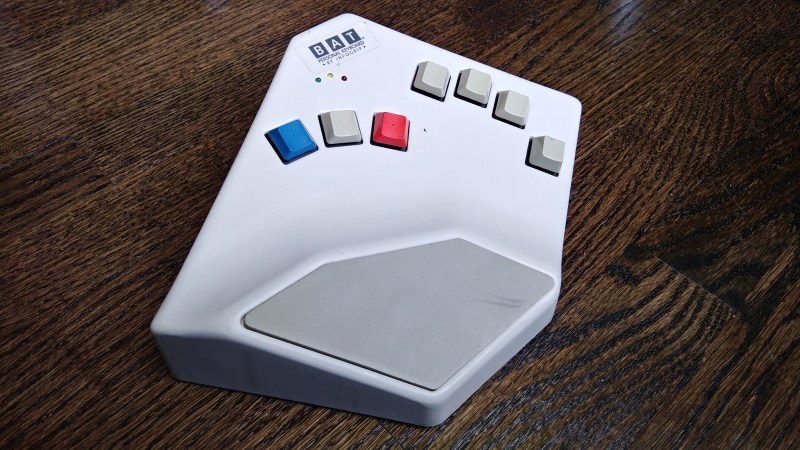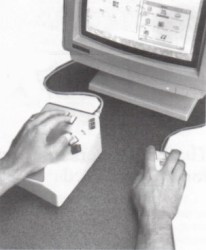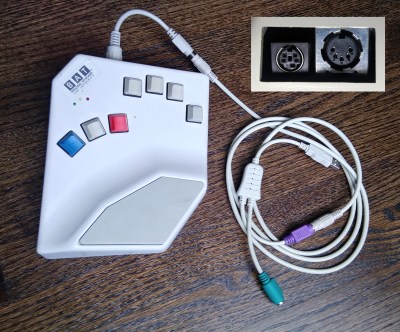I guess it shouldn’t surprise me that by researching weird and interesting keyboards, I would uncover more weird and interesting keyboards. This is the BAT personal keyboard by Infogrip, and it’s something I came across while researching the DataHand keyboard and mentally filed away as something cool to look into.
When I came across a used BAT for a reasonable price, I snagged it, even though it didn’t come with any of the manuals or software, not even a cord. Like I said, reasonable price. I looked these keyboards up and found out that you can buy them new for a lot more than what I paid.


So what is this thing? It’s a chording keyboard that’s meant to be used a standard PC input device by anyone who either can’t use a regular keyboard or has a need for speed. Years of research went into the BAT’s chording scheme, which was developed in conjunction with NASA’s Stennis Space Center.
Instead of stretching your fingers all over a regular keyboard, poking keys one at a time to spell out words, you press combinations of keys simultaneously, like playing chords on a piano.
You’re meant to use your thumb for the red, grey, and blue keys, and lay the other four on the rest of the keys. All of the alphabet keys are chorded with or without the gray thumb key, and all the number, symbol, and modifier keys are accessed through the red and blue layers.
Why would you want one of these? Well, given enough time to learn the chords, you can do anything a standard 104+ keyboard can do with only seven keys. You would never need to look down, not even for those weird seldom-used keys, and the only finger that ever travels is your thumb. All of this reduced hand/finger/wrist travel is going to be easier on the body.

The BAT is also part programmable macro pad, and from what I can gather, the main selling point was that you could quickly input shortcuts in CAD programs and the like, because you could keep one hand on the mouse.
The BAT came in both left- and right-handed versions that can be used either alone or together. Imagine how fast you could type if you chorded everything and split the typing duties between both hands! The only trouble is learning all those different finger combinations, although they say it doesn’t take that long.
So why is it called the BAT? Legend has it that it’s because company started out in Baton Rouge, Louisiana, but also because a pair of BATs sitting next to each other resembles a bat (PDF).
Connector Inspector
This version of the BAT seems to be from the middle of the availability timeline — the late 1990s. It has an AT port and 5-pin mini DIN, which I originally mistook for PS/2 from the seller’s pictures. Whoops!

The first thing I did was email the company about a replacement cord. I thought these keyboards were still being made, because they have new ones that look very much like this one, but come in black and use USB. I got an email back from a rep who told me Infogrip went out of business, and that their company is selling off the new old stock until it runs out.
I started my initial cord searches with the mini DIN side, and my thinking was simply that it’s newer technology. Yes, but it turns out that mini DIN cords are kind of uncommon and difficult to find — at least cords that terminate in something I can use on the other end.
The BAT started out with an RS-232 serial port, then moved to this AT/5-pin mini DIN version that I have, and then to USB-Boxy sometime in the early 2000s. I gave up on searching for a mini DIN when I found a cheap AT to PS/2 converter and equally inexpensive PS/2 cable to use with one of those PS/2 to USB cables that you couldn’t swing a ball mouse without hitting in the early 2000s. It seems to work, at least partially. My system recognizes it and declares it ready to use. I can get all the LEDs to light up, but none of the chords I try will produce output in any text editor I’ve tried. I might have better luck if I can find an AT to PS/2 cord.
Tour and Teardown
It’s difficult to give a fair assessment about a device without using it for a while. So far, I haven’t been able to do that. But outwardly, the BAT feels like it was designed for the best possible user experience.

The point of a keyboard like this is that you should never have to look down at your hand(s). To help with that, both of the red and blue thumb keys have homing bumps, and the gray one doesn’t.
All the keycaps seem to be mounted backwards, as in 180° from normal — and based on the pictures I’ve found, this is how Infogrip intended them to be. This way, the keys have a really low profile and are easier to actuate. The pinky key is taller than the rest to account for how short and weak pinkies tend to be. And underneath each keycap, there are three layers of 1/8″ thick foam to absorb the shock of typing.
The BAT’s keyswitches are Cherry MX blacks that have been modified with exceptionally light springs that make them take even less force to actuate than reds. I can’t fathom how they could have made this keyboard any easier or more comfortable to type on, unless maybe the wrist rest was gel instead of foam, or it had adjustable tenting to change the typing angle.
I don’t understand why it has a coin cell, especially considering this troubleshooting blog post from Infogrip that suggests removing the battery altogether because “you don’t need it and it can cause problems”. Does anyone know or care to speculate? I did try this, along with the hard reset sequence, but it still behaves the same way.
Will This Become My New Favorite Input Device?
I’m going to try to get this keyboard to work as it’s supposed to. But if that doesn’t happen, I think it would make a fantastic macro pad, especially if I come up with my own scheme for chorded shortcuts. And there’s plenty of room in the case to design a board that fits the keyswitch footprint.
Since my hand is small, there might be enough room for a trackball just below the thumb keys, and some mouse buttons and a scroll wheel under the other keys. I’m in the middle of designing a 5-key macro pad that will sit right in front of my trackball mouse, but the idea of combining a trackball mouse and a macro pad into a track-ro is tempting. We’ll see how it goes.





















Chording can be an incredibly fast input method. Stenographers do this and it’s impressive to see an accurate steno transcription happen in real time.
You should check out a used Stenograph machine if you’re into chording your input, might be fun!
Disclaimer: I worked for Stenograph corporation decades ago.
I have one! It’s waiting for me to clean it and so on. Poor thing.
Speculation on coin cell:
Was intended to support some feature that didn’t make the final firmware.
I have a project that initially was planned to have an RTC. Board includes all the parts (including soldered coin cell), but the firmware architecture changed mid-project and it doesn’t currently do anything with the RTC data.
About 150 units per year are still being produced, complete with unused RTC & coin cell, because change is not simple.
My guess is that the coin cell is backing up the ram that stores the user programable programmable macros.
So you don’t have to re-program them when you turn on/off the PC.
That was my guess, but then I found where Infogrip said the battery isn’t necessary and can cause problems.
In the worst case, you can always do a brain replacement surgery on the device — put a modern microcontroller with USB support in it, and program it using the documented chords as a reference. Might actually be less work than figuring out what is wrong with it.
I was thinking about a half-way-house. See if you can spot serial data anywhere on the existing board or connectors and take that into a microcontroller to convert to USB (or Bluetooth)
It’s rather like the microwriter from the early 80s. These were pretty amazing, an RCA1802 battery powered, handheld word processor.
https://en.wikipedia.org/wiki/Microwriter
and like the Microwriter, I wonder if it was intended to be used offline writing into that 32k battery backed ram, and then you could trigger it to squirt your novel out over the original serial port.
32k seems like an awful lot of macro storage space
Could you put up a picture of the non-component side of the board? The main question I have is if the P1 connector is a power supply connector. You wouldn’t think it would need it, but you never know.
Ah, having looked a little more, I see it mentioned that P1 is an ADB connector (with more contacts than necessary).
You might try using a different USB to PS/2 adapter. In my experience with IBM PS/2 keyboards, I’ve noticed that some USB adapters don’t work with them, while others do.
You just reminded me that my new computer has a PS/2 port! If it still doesn’t work, I might get an AT to PS/2 cable.
Well, this isn’t going to work at all (passive PS2 -> USB adapters). TL;DR, such adapters work with devices with controllers supporting operation as USB device. For older keyboards like this one or let’s say a vintage mech you need an active controller which converts PS2 data to USB data because directly these connections are incompatible with each another.
This would be amazing for AR or a real Linux phone like the PinePhone. Such a chording keyboard, could be quite small, in the form of a dataglove or even integrated into clothing. The cyberpunk inside of me is touching his private parts! A simple head mounted display connected to a pinephone or a laptop and I could walk while coding. Are there any modern interpretations? I think it would not be too difficult to build one oneself, anyone interested?
https://www.tapwithus.com/?gclid=EAIaIQobChMIi874rpCo6wIVxx-tBh0TqgycEAAYASAAEgKoAfD_BwE
This thing already exists… but it’s not really suitable for what you are talking about. Despite all the video of people walking around and tapping out on their legs it really only works on hard surfaces, doing it on anything soft makes the tap detection error rate go through the roof. Also getting it to read properly you end up basically bobbing your whole arm up and down a lot to make it so your fingers all land at the right time. The other thing is that unlike the one from the post to get to special and number keys you have to do an extra tap to change modes, so good luck typing something like “def foo (bar=“baz”):”
Still for regular text it could be reasonably fast but the detection error rate is a hard limit of speed.
All the ’90s and early 2000s wearable computing researchers seemed to use a handheld chording keyboard/mouse combo called a Twiddler; in checking, I found the company’s done a mark three version from 2015 ( https://twiddler.tekgear.com/ ) with USB/Bluetooth in place of the original’s serial line tether. I think there’s various DIY versions about as well.
I took notice of the rubber padding under the keys. This would not be for me and others. Typing and electrical musical keyboards share a lot of ergonomics.I know of organists that hit the keys like they are playing piano loud, and they wear out the contacts especially those rubber type. I would call the feeling “mushy”, only on a keyboard with pressure based aftertouch should there be any vagueness as to bottom of travel, in silence.
If you are suffering from pain because of hitting the keys and feeling the bottom is hitting back, ease up. Speed doesn’t mean hard.
I definitely agree about hitting the keys too hard. But I think they just did it for added comfort. I’m not into linear switches at all, but I don’t feel like the foam makes the keying experience any more mushy.
I think it’s time for me to built a Braille keyboard with some extensions and shortcuts. I learned to read Braille by fingertip back in the middle school when my mom was scared that I’ll go blind completely. It took me 6 months to learn it, and six more to forget most of it. Still Braille or standard Stenography chorded keyboard would be better choice than any of these proprietary formats some companies tried to sell…
Yeah, when I was in middle school, my mother said I’d go blind too, but what was I doing that prompted her to say that?
B^)
I have a chorder that uses the same layout and chordset as the BAT, hacked from an Atmel 32u4, the FeatherChorder sources from the Spiffchorder folks, and a version of the Arduino Keyboard library I tweaked to handle raw scan codes, quick post here https://pappp.net/?p=1646 from last time I swapped the electronics out in 2017. It’s hooked up to MX Browns clipped into a plate hastily CNC’d out of HDPE sheet, which is usable but not ideal.
I like the design but I was way, way too cheap for a real BAT.
I’ve had chorders with that configuration around for a decade, and try to use them on-and-off, but always end up having problems with getting the chordset deeply in my fingers because of my level of qwerty habituation; I sometimes even catch myself making a little twitch for the qwerty motion before I do the chord. I’ve also had some fatigue issues with it, but I’m pretty sure that’s because I’ve been running unmodified MX Browns.
Bummer to hear Infogrip is going out of business, the BAT was the most polished, longest surviving chording keyboard on the market, even if it was damned expensive.
Seeing as that has a P80 microcontroller, RAM and an EPROM you can pretty much guarentee that it was programmable from the PC side (with battery to maintain RAM). This was common on early POS keyboards which often had user key switches (as in actual lock and keys) as well as mag stripe readers. The programming was done over the usual cable from config software that usually ran under DOS. It may even of had a TSR program that ran under DOS to provide programming functionality originally. I guess these pre USB programmable keyboards used the underlying provision for status indicator LEDs to upload the data? You may find the AT socket is for plugging in a secondary keyboard or peripheral (like a keyboard wedge mag stripe or barcode scanner) and the OEM lead would of been from that 6 pin mini DIN to AT plug…?
But you need 5 fingers
…
Maybe you should try a newer chord keyboard like the DecaTxt. $125 on Amazon.
“like playing chords on a piano”
…. not really.
Watch a piano player play chords. There are two MAJOR differences between playing chords on a piano and how a keyboard like this works.
A piano player doesn’t press the same places on the keys for every chord. It would be difficult to do so, as your fingers are connected to each other and can’t truly be moved independently of each other.
Second, you don’t play chords on the piano by pressing unique combinations of the same stationary set of keys. Instead you play one of a few combinations of keys in different positions on the keyboard.
The only thing a chording keyboard has in common with playing chords on a keyboarded instrument is that you press more than one key at a time with one hand. Otherwise it’s an extremely tortured analogy.
You must be a hit at cocktail parties!
I used to have one of those but returned it- it kept crashing my mac! The chords are indeed easy to learn. At one point I toyed with the idea of building a case for my phone using the same chords. Still seems like a decent idea!
cw
Re PS2-usb adapters. Sometimes you need to plug the ps2 end in first, then unplug and replug the USB cable every time your computer boots. I have half a dozen different models due to various incompatibilities. I also recently found a BAT but I haven’t tried it yet
Good Day from Hamburg, Germany,
I recently got my hands on a pair of the same Keyboard like yours. I’m dealing with the same problem, I get no output. Was you able to solve that problem? Do I need another PS/s 2 USB Adapter, maybe even native PS/2?
All the Best
Alexander
So, here Alaxander again,
I know the solution/reason but it’s not any help for most of you:
The Keyboard is probably fine, 100% working, but the PS/2 2 USB Adapters not so much.
It’s working fine on my aged PC with nativ PS/2, definitively the Adapter is the perpetrator 🙂↕️
Since I have many adapters from another project, was looking for one which works fine but never found one. So I will check all of them and if I remember I will write here about it. But I doubt any of them is working.
Okay,
-Belkin not working ( with Cypress Chip )
-LogiLink not working
-HP not Working
I think I have to make my own Soarer’s, hopefully that’s one solution.
Never got my hands on a blue cube but probably it won’t work too 🫢